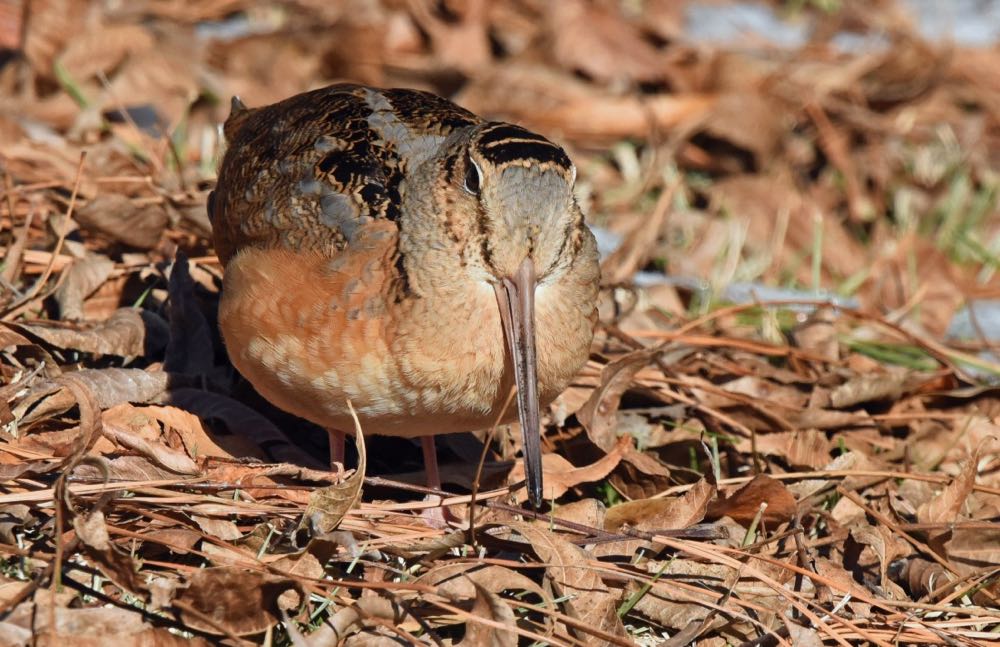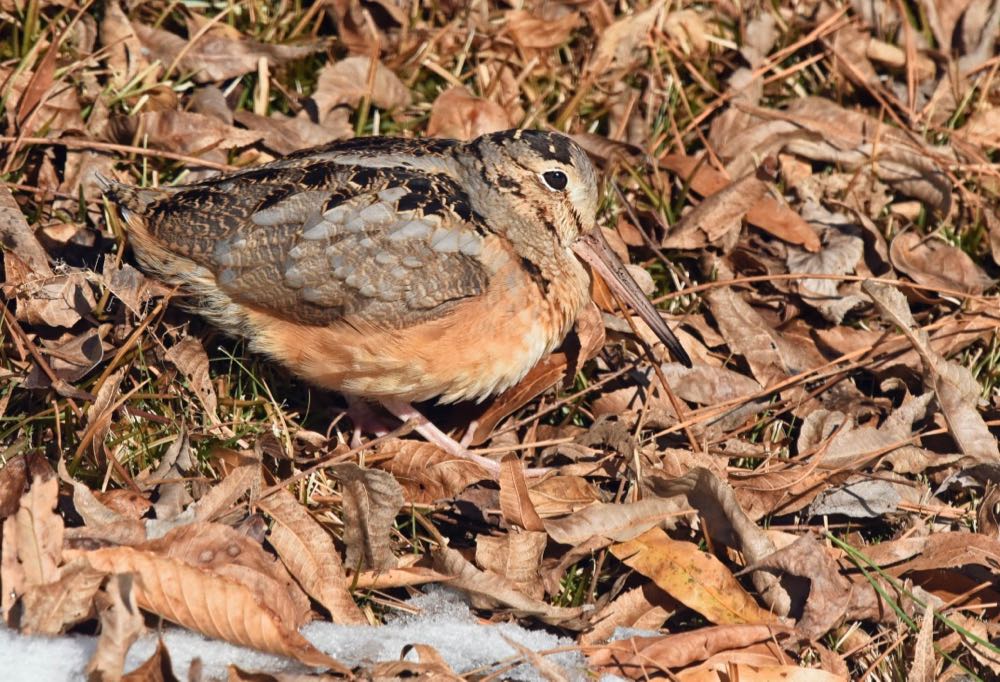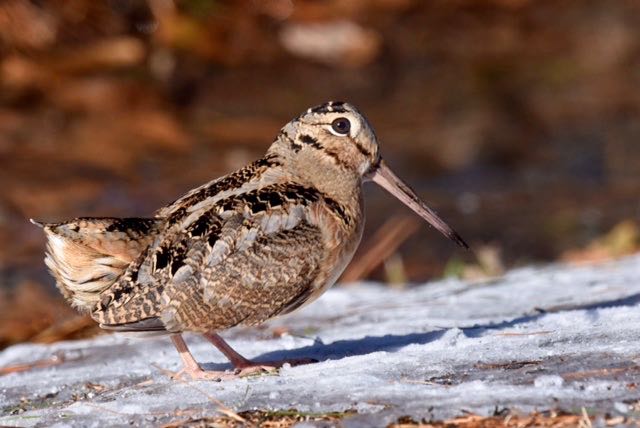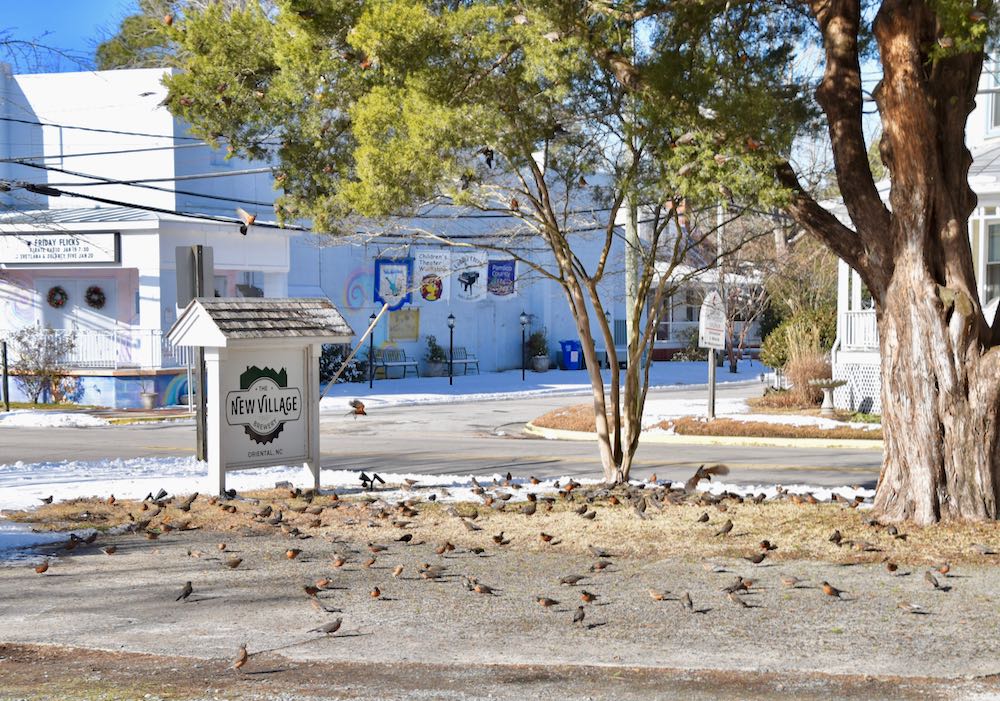It's Wednesday May 1, 2024
News From The Village Updated Almost Daily
January 9, 2018
Last weeks snow and the lingering subfreezing temps may have kept many humans inside in recent days. Bird watchers near Oriental braved the cold this weekend after word spread that woodcocks, rarely seen in town, had descended on Oriental in large numbers.Woodcock sighted near Oriental’s 3rd Avenue Saturday. (Greg Perry photo)The Woodcock is also known as the Timberdoodle and as both names imply, it usually lives and forages in the woods. But a few days after the snow fell, these broad-breasted birds were showing up in yards in town, using their distinctively long beaks to hunt worms and bugs in the ground under trees and shrubs where snow had melted.
Woodcock foraging beneath a shrub on South Avenue Monday.As it does in its usual forest habitat, the woodcock’s protective coloring helped it meld in with the brown lawns of winter and the crinkled tan leaves left from fall. Normally, if you weren’t looking for one, you might not notice it. But there were so many this weekend, that even some casual observers walking by or glancing out the window couldn’t miss their pudgy silhouettes.
One of hundreds of Woodcock sighted in the area over the weekend. A grouping of them would be a “Fall of Woodcock.” (Greg Perry photo)On Sunday, Sarah Goodnight reported seeing 78 in Oriental, 50 more in the sunny side ditches and banks along the Oriental Road on the other side of the bridge, 47 at Dawsons Creek and a handful at the entrance to River Dunes.
Why so many in town now? In other winters, bird watchers elsewhere along the coast have noted abnormally large numbers of Woodcock coming to town after heavy snows covered the woodcock’s usual woodland habitat and hunting grounds. Liz Lathrop, who has tracked the comings and goings of birds in Pamlico County for decades, saw a similar connection with the influx of Woodcock in Oriental this weekend. “Snow and extreme temperatures,” she suggested, may have “pushed the birds to the coastal plain.”
Woodcock and long beak in profile. Longtime Oriental birder Liz Lathrop recalls being asked years ago to tend to an injured bird that someone had found and described as looking “‘like a giant hummingbird.’ Boy, was I surprised when I picked up the bird and discovered it was a Woodcock.” (Greg Perry photo)There was some talk that this was what birders call a fallout, or a mass migration. But Lathrop also noted that “Woodcock are here year-round and breed here,” and so, it might not have been a fallout, per se.
“As in so many questions re birds, there is no definitive answer.” she said. For her, the birds’ motivation was secondary to just having so many of them show up.
“It was most delightful to see so many Woodcock in town, whether they were local birds mixed with some wintering here moving to the sunny spots to feed, or whether some came from a distance because of the storm. Many people got to see a bird they would never see otherwise right on Main Street.”
It should be noted that the Woodcock were not the only birds flying in Oriental in recent days.
Birds of different feathers outside the New Village Brewery Monday morning.Killldeer and Wilson’s Snipe (Yes, snipes do exist) also visited in larger numbers than usual. As the video below shows, the cedar tree outside the New Village Brewery was a busy place Monday morning. (Not for the faint of heart…)
Woodcock Update (1/10/18)
More on woodcock behavior in a note from Oriental resident Bob Miller:Nice article on woodcock. I’ve observed them walking in a bouncing motion. Apparently this is because they stomp a foot and listen for earthworms and other critters in the soil. The long bill then probes for a meal.There is another woodcock performance yet to come.
In spring the males go to display clearings in the forest and fly upwards to nearly 300 feet in a circular pattern making sounds with their feathers. They then dive in a zigzag pattern back to the ground. Females wait on the ground and select the male that impresses them most to mate with.




